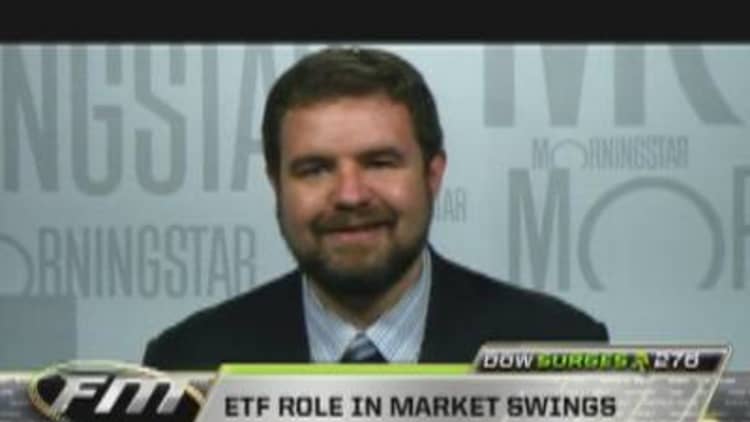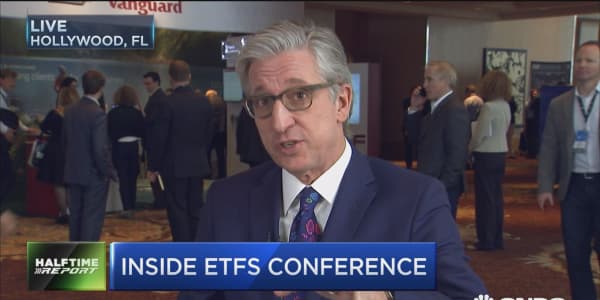January has been a good month for quick-trigger believers in profiting from short-term market volatility: The kind of spike in the VIX volatility index that historically took a month to play out took just two days last week. The markets, meanwhile, sold off by 3 percent in two days—compare that with recent 5 percent to 8 percent declines that took a month to play out. The polar vortex caused natural gas to hit its highest level in three years.
Leveraged and inverse exchange traded funds (ETFs) were not long ago the poster children for ETFs gone bad, with an investing style predicated on uber-aggressive market bets. But recent market events served as a reminder that there are ETFs designed to profit from conditions that spook many investors.
"We are continuing to see people using these products sporadically when conditions are right, and less so at other times," said Nick Cherney, chief investment officer at VelocityShares, which offers leverage and inverse ETFs.
This has been one of those times when at least some conditions were right.
"The polar vortex has led investors to expect sharp moves in natural gas over relatively short time frames, and as a result, trading in VelocityShares' 3x Long Natural Gas ETN (UGAZ) and VelocityShares' 3x Inverse Natural Gas ETN (DGAZ) increased dramatically," he said.
(Read more: Fitting a star fund manager inside in ETF)
These ETF "bad boys" seem here to stay, too: More than $3.5 billion went into ETFs shorting the market last year, according to Lipper data. "It's kind of interesting that the gamblers out there have been pulling money from leveraged long products and adding money to the short trade—exactly the opposite of where the market has been going," said Jeff Tjornejoh, head of Lipper Americas Research.
The past few days were a good time for those gamblers.
"If you bought [the VIX] Thursday, that's a nice move," said Kim Arthur, CEO of Main Management.
Equity long leverage ETFs
| Year | Flows($bil) | Assets($bil) |
|---|---|---|
| 2006 | 0.26 | 0.53 |
| 2007 | 1.22 | 1.9 |
| 2008 | 8.38 | 7.01 |
| 2009 | (5.44) | 4.96 |
| 2010 | (1.45) | 4.5 |
| 2011 | 1.89 | 10.02 |
| 2012 | (2.98) | 10.71 |
| 2013 | 0.31 | 17.65 |
| 2014 | (0.26) | 17.92 |
Source: Source: Lipper Americas Research
Originally launched in 2006, leveraged ETFs use financial derivatives and debt to magnify the returns of the underlying index they track, sometimes by two or three times for a single day. Inverse ETFs try to achieve the opposite performance, by using derivatives to profit from a decline in the value of an underlying benchmark. The result, for investors in these products, was often huge gains, followed by huge losses.
Not surprisingly, it didn't always go so well. Investors, and even their financial advisors and brokers who sold these products, didn't completely understand their complexity, leaving them unable to properly disclose risks involved. A flurry of lawsuits followed.
(Read more: Emerging markets ETFs: Which to buy, which to avoid)
Just this month, the Financial Industry Regulatory Authority (FINRA) announced that it settled with Stifel and broker affiliates to pay combined fines of $550,000 and close to $475,000 in restitution to 65 customers that were sold leveraged and inverse ETFs from 2009 to 2013. The suit stated that the sellers did not adequately understand these products when recommending them to their clients—the settlement required no admission of guilt.
The key issue that people didn't understand about leveraged and inverse ETFs is that they are designed to "reset" daily, meaning that their performance can quickly deviate from the performance of their underlying index or benchmark. The multiple is the intended leveraged or inverse factor that the fund is aiming for, such as two times or negative one times the index.
"The problem is that funds deliver this multiple for only one day," explained Paul Britt, senior ETF specialist at ETF.com. If investors hold the fund longer than that, then there's no assurance that they will get that multiple. "This does not make the products unusable for periods greater than one day, but investors must rebalance to achieve the multiple for longer periods," Britt said. "If they don't, they can find their returns quickly plummeting, resulting in magnified losses in a volatile market, even while the long-term performance of the index is showing a gain."
Or as Arthur put it: "You still have to be a day trader, very short term, to look at something like the VIX exchange traded portfolio [VXX]."
Equity short leverage ETFs
| Year | Flows($bil) | Assets($bil) |
|---|---|---|
| 2006 | 1.14 | 1.64 |
| 2007 | 5.4 | 7.53 |
| 2008 | (2.68) | 10.57 |
| 2009 | 19.18 | 17.62 |
| 2010 | 7.29 | 18.68 |
| 2011 | 6.71 | 12.67 |
| 2012 | 1.25 | 9.37 |
| 2013 | 3.58 | 8.65 |
| 2014 | 0.24 | 8.79 |
Source: Source: Lipper Americas Research
(Read more: 3 big risks, 3 big opportunities in ETFs)
Arthur doesn't use these ETF products, either—though he said he does have his eye on VIX ETFs as a way to play swings in it—but he doesn't think there was ever really a problem with these ETFs. "They were developed by trading desks for traders to get products with tons of volume, KIm said, adding, "not built for people who said let's put it into asset allocation and walk away. ... They were perfectly constructed to do what they were supposed to do."
What was lacking—and led to the recent lawsuit settlement—was the right level of education. Richard Ferri, founder of Portfolio Solutions, said, "Nothing has really changed about these products" other than that "some brokers got slammed when regulators came in."
"A lot of these funds are now extremely liquid, and that is another sign of investor acceptance, even though there have been misunderstanding about them in the broader universe," Britt said. Because many of these ETFs are geared toward short-term exposure, "they are now being used more as tactical tools to get in and out of funds without undo cost and headaches," Britt added.
John Largent, chief investment strategist at Members Trust Company, an advisor who doesn't invest in these products for clients, said these ETFs may be used for a short-term hedge. "Everyone is more educated about these products today, and people know they are a trading vehicle and not a long-term hold," Largent said.

Cherney said that when these products were first launched, "they were so volatile that the daily reset was causing even inverse products to lose money. There has not been the type of complaints about these products that there was back in 2008 and 2009, when they were losing money," he said. Steps taken by industry regulators, namely the Securities & Exchange Commission (SEC) and FINRA, to assure that issuers and sellers of these products properly inform advisors and investors about how these products work and the risks involved in investing in them, has indeed helped to usher in a rebirth in usage of leveraged and inverse ETFs in trading, Britt said.
Still, Ferri cautions that leverage and inverse ETFs remain risky and complex investments. "They are not for mom-and-pop investors," but rather for hedge funds, institutions and "investment advisors who know what they are doing."
"What's key for investors to understand is that rather than viewing these products in terms of one input—whether the market will go up or down—they need to understand that there are three inputs to think about: the direction of the market, the time period invested and how volatile the market will be," Cherney said.
—By Leslie Kramer, Special to CNBC.com




